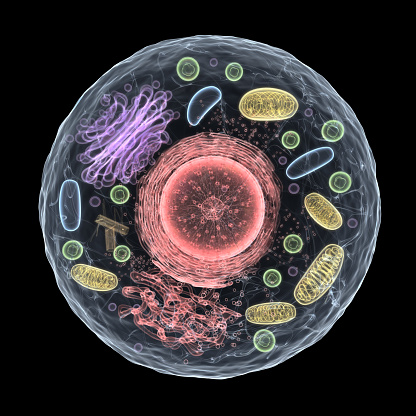Discovery of metabolic switch in flies could have wider impacts

3D animal cell on black background.
The recent discovery of a metabolic switch at Iowa State could lead to the treatment of cancer and childhood obesity.
The research was done in fruit fly larvae to test if the production speed of fatty acids could be regulated.
Hua Bai, the lead researcher for the study and associate professor of genetics, development and cell biology (GDCB), explained the research process and how he was able to manipulate the fatty acid production in developing fruit flies.
“What we studied and discovered here is how developing animals will gain or accumulate fatty acid at a relatively fast speed in order to support faster growth during animal development,” Bai said.
Bai said the ability to modify the protein structure of the developing animal and regulate fast fatty acid production during development — the metabolic switch — was an unexpected discovery.
“The switch word identifies a kind of unexpected regulation for that particular protein involving fatty acid production,” Bai said.
Bai said there were multiple surprises during this particular study regarding the discovery and what the team set out to research.
Bai explained in an email response to the Daily that in previous research, it was thought that fatty acid synthase, the major protein involving fatty acid production, is regulated through protein translation. He said the study revealed that synthase expression did not change during animal development.
“A specific protein modification of fatty acid synthase, called acetylation, was greatly induced in developing animals,” Bai stated.
Bai said the fatty acid synthase is an essential protein in the cell, and mutating the entire protein will cause lethality.
“But when we mutate only one residue of the protein to block the switch, they [the animal] will not be dying; they just produce less [fatty acids] and grow slower,” Bai said.
This discovery had not been previously investigated, Bai said, and other researchers had noticed the modification, but the location in the protein structure still needed to be found.
He explained that although this had not been tested on humans, there is significant evidence that the discovery could be translated to human disease.
“For example, you can be able to develop drugs to either block or enhance the switch because the switch is very small; [it] can be very easy to manipulate through pharmaceutical intervention,” Bai said. “We could potentially fine-tune or control the fatty acid production.”
Bai said this discovery could be applied to treating childhood obesity or cancer.
“If there’s a similar mechanism or switch happening in adulthood, potentially the same mechanism or treatment can be applied to obesity, diabetes and cancer,” Bai said. “[It] also has some relationship with regulation of fatty acids.”
Ting Miao, a postdoctoral research fellow and a GDCB graduate student, said because there are many biological pathways between fruit flies and humans, their research may provide insight into treating childhood obesity.
Miao said the research was done to examine the role that fatty acid regulation could play in metabolic regulation.
“In recent years, we found that this modification plays a very important role in regulating metabolism,” Miao said.
The role of this modification in fetuses with more fat was unclear, Miao said, especially during animal development, and that was why they focused on this specific modification. The growth of the fruit fly larvae is so rapid and the fly gains large amounts of fat during development, she explained, it was the best choice for a test subject.
“We used fruit flies as the model —the fruit fly larva — as they grow really fast and fatness is very efficient during larval development,” Miao said.
Yanhai Yin, professor and department chair for the genetics, development and cell biology department, explained the significance of this research and discovery in relation to human health.
“I think that information will be very important to try to optimize conditions for human health, and so it’s an important piece of our research mission,” Yin said.
Yin said that the department hopes to promote this discovery and motivate students to participate in the research process.
“It would be good for students to know that we have these opportunities for them to come to learn what our scientists are doing and some of them will have opportunities to work on some of the exciting research projects,” Yin said.
This research demonstrates how significant the process of scientific discovery is, Yin said. He said that the original hypothesis for Bai’s research did not work, and as a result, the research moved in a different direction using a different hypothesis, which led to the discovery of the metabolic switch.
“Sometimes you need to modify your hypothesis,” Yin said. “For students, graduate students and undergraduate students, if you stick with your question, keep working hard on it and it will generate some important insight that could be very helpful for human health.”
Your donation will support the student journalists of the Iowa State Daily. Your contribution will allow us to purchase equipment, send our student journalists to conferences and off-set their cost of living so they can continue to do best-in-the-nation work at the Iowa State Daily.












